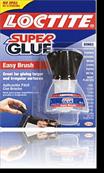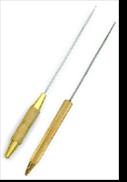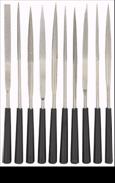FLY TYING WITH CYANOACRYLATE = CA – SUPER GLUE
Part I – How to Glue
Get several fly tiers around a table and there is sure to be disagreement on the best glue to use for joining fly tying materials. To some it may as well be politics or religion.
The little mission church deep in the bayous was the poorest in the Diocese. At Sunday services the priest explained to his congregation that the church was desperate need of some extra money for repairs, so he asked them to consider being more than generous. He offered that whoever gave the most would be able to pick three hymns.
After the offering plates were passed about the church, the priest glanced down and noticed that someone had graciously put in a $100 bill. He excitedly said he'd like to personally thank the person who placed the money in the plate. An older woman raised her hand.
The priest asked her to come to the front, so she slowly she made her way towards him. The priest told her how wonderful it was that she gave so much, and in thanks he asked her to pick out three hymns. Her eyes brightened as she looked over the congregation.
She pointed to the three most handsome men in the church and said, “I'll take him and him and him.”
CA glue has been around since World War II (1942 actually) but has only become popular for fly tying use in the last couple of decades. Cyanoacrylate (CA) glue is an acrylic resin which curiously uses water as a hardner. Cyanoacrylate is actually the generic scientific name for a variety of adhesives sold to the public, plus other versions which are used for medical or veterinary closures. Non-medical varieties are often called CA glues, or instant glue or Krazy/Super glue. They come in thin, medium and thick (gel) consistencies.
CA glue is interesting because it seems to work bassackwardsly. CA glue works with water. If it is used on a totally dry surface it won’t form a bond with the surface. There must be some water present (moisture is enough) for the molecules of the glue to have a chemical reaction and adhere the surfaces being bonded. Just breathing on the material may create enough moisture for a stronger bonding reaction. And because the hardening happens very quickly after the water and cyanoacrylate make contact (they immediately form a strong bond) the “super” aspect of the glue becomes apparent.
Consider that ethylene vinyl acetate (EVA or flip flop foam) is prized for a variety of uses because it is essentially waterproof. Even so, the surface picks up available moisture. The same is true for polyurethane (sheet foam, insulation and gaskets, etc.). That little bit of moisture is all you need to get adhesion with CA glue. Of course, because human skin is naturally moist, full of ridges and very porous, it is not unusual for CA users to stick fingers to each other, or to the foam. yers who use CA glue regularly adapt a sort of “so what?” attitude and eventually cease to notice glue covered fingerprints. But, if having glue on your fingers really bothers you, there are commercial glue removers available. You can also use an emery board to file off the glue, but I wouldn’t recommend it. Otherwise, the residue will wear off naturally as your body oils break down the glue’s bonds.
As mentioned, some varieties of CA glues are used in medicine. Where stitches were the standard practice to close wounds, some tissues are now adhered back together with medical glue. Just like getting it on your hand, the medical glue is eventually broken down by the body and doesn’t require removal. Pretty slick, huh?
The best fly tying use for CA glue is in the company of closed cell foam (EVA or polyurethane). From bspitt (a chemist) on the FAOL bulletin board, we learn that “craft foam is a polyurethane closed cell foam. It is a polyol (weak base) resin reacted with an isocyanate. The isocyanates are similar chemisty to the super glue. So not only does the super glue react with the thin layer of moisture on the foam, but it actually cross links with the polyol resin (left over unreacted sites) within the foam. So the bond is much greater and will hold better and longer. You will probably see a failure in other areas of the foam before the foam - super glue- foam bond breaks.” How cool is that?
By the way, if the gluing process doesn’t work quickly, I’m sorry to tell you but it’s you (not the glue) that has done something wrong. About a thousand flies emerge from my foam/glue process every year. Most never have an issue. When they do, it’s because I messed up.

Is there a preferred way to use CA glue on foam flies? Well, my preference is using Loctite brush on – easy application and it goes where you want it. Should be about $3 at Wal-Mart. Put only a light coating on one side of the foam to be glued (yes, you only need it on one of the pieces of foam). Put the foam pieces together and press. Hold for about 10 seconds. Tug to make sure you didn’t do something wrong. That’s it. Now you can shape the foam.
How should you go about gluing foam to the hook? When you are going to put a foam body on a hook, you can make sure it doesn’t move (rotate) on the hook by applying CA glue. The first thing you always want to do is lay down a layer of thread on the hook shank the paint this with super glue. If you push foam onto the thread it will stick instantly. Suppose you are making a popper and want the hook to pass through the foam. In this case, use a needle file to carve out a hole or heat the end of a bodkin to put a hole in the foam. Put a layer of thread on the hook shank and paint that with super glue. Push on the foam body (quickly) and it will adhere VERY fast.


Heat a bodkin? Yep. Closed cell foam melts. Imagine that you have a foam plug ready to make a popper. Push the long pin part of a bodkin through the foam in exactly the alignment you want for the hook shaft. (You use a bodkin because a simple needle is either not long enough or will get too hot to hold.) You should have the bodkin point sticking up to an inch or more out of the foam. Heat this pin tip (not warm but red hot) and slowly pull it back through the foam. It will melt out a pathway as it leaves. To make a bigger hole, wiggle the needle as you pull it out, or you can use the bodkin hole as a guide to enlarge it with a file. (Needle file sets are available from www.harborfreight.com and similar stores for about $8)
How do you add legs? If you are going to have rubber or silicone legs on the fly, insert them through the body before you put it on the hook shank. It is easiest to use a large canvas or upholstery needle, thread the legs through the needle eye, pierce the foam and pull the needle through until you can slide out the legs. You want to try and thread the legs through (and perpendicular to) the hole you have made in the foam with your bodkin or file. When you eventually push the foam on the thread and glue covered hook shank, the legs inside the hole will simply bend out of the way but will end up super glued, with the foam, to the shank. Works every time.

Parts II and III of this article series will explain the process of how to manipulate foam into flies. Starting foam fly making requires a bit of buying. The cheapest way to start if foam sheets from Michael’s or Hobby Lobby or the Dollar Store. The first two have 2mm and 3mm foam and DS has 1.5mm in limited colors. Expect to pay about $1.25 a sheet (unless it’s on sale) except for the DS where 5 sheets are...duh...a dollar. Many folks cut up old flip-flops, but you have to make sure the sole is foam all the way through and not thin foam slices around a sponge middle.There is really good 5/8" foam available from a number of sources and a couple of 2'x2' mats from www.softtiles.com will be a lifetime supply for most folks. Alternatively, several layers of sheet foam can be glued together, but, you don’t want to glue whole sheets together. Cut pieces just a bit larger than size you need to punch out a couple of cylinders and glue these pieces together. Oh, and you will also want to acquire something to cut out plugs of foam. Hollow punches from www.harborfreight.com are the cheapest at $6 for nine sizes.
Next article, patterns and how to.
